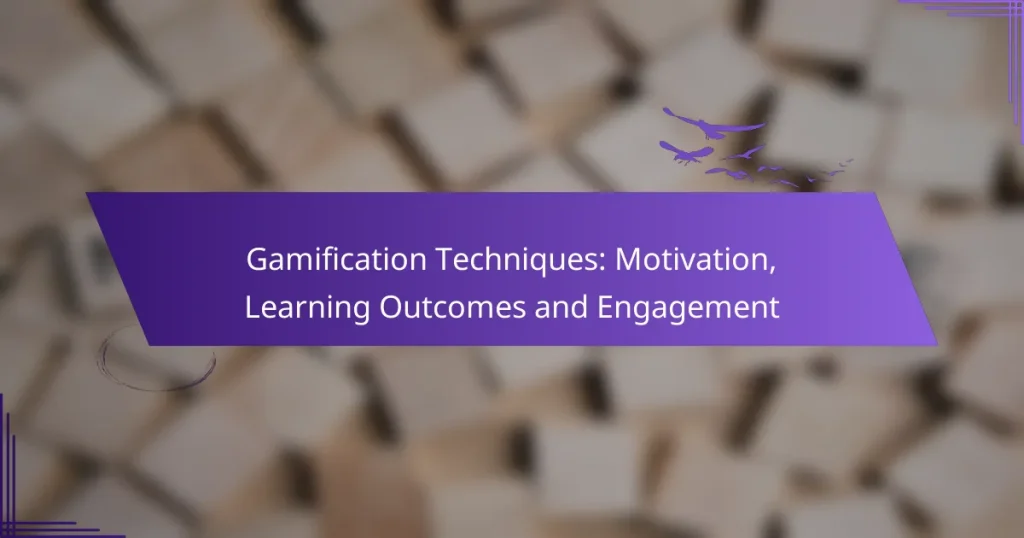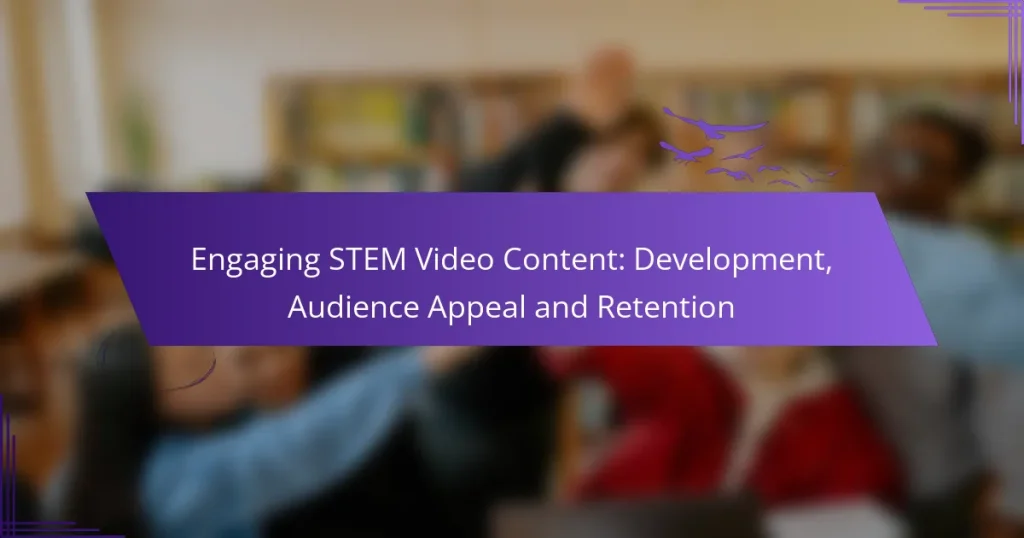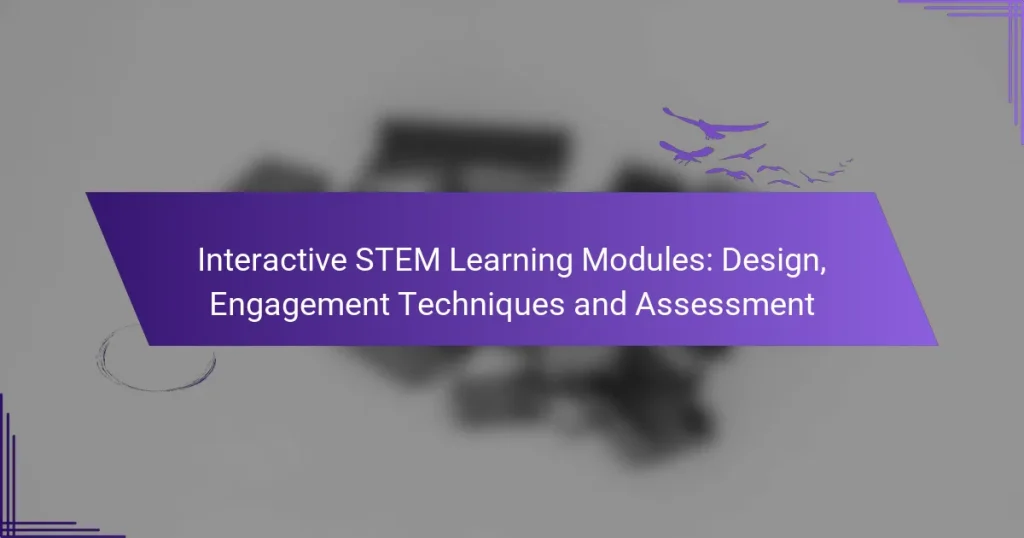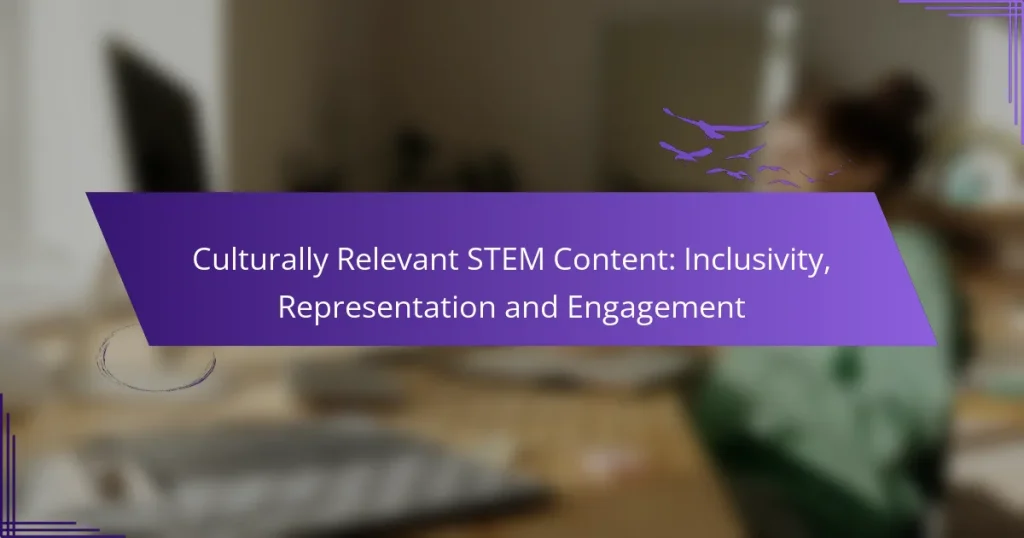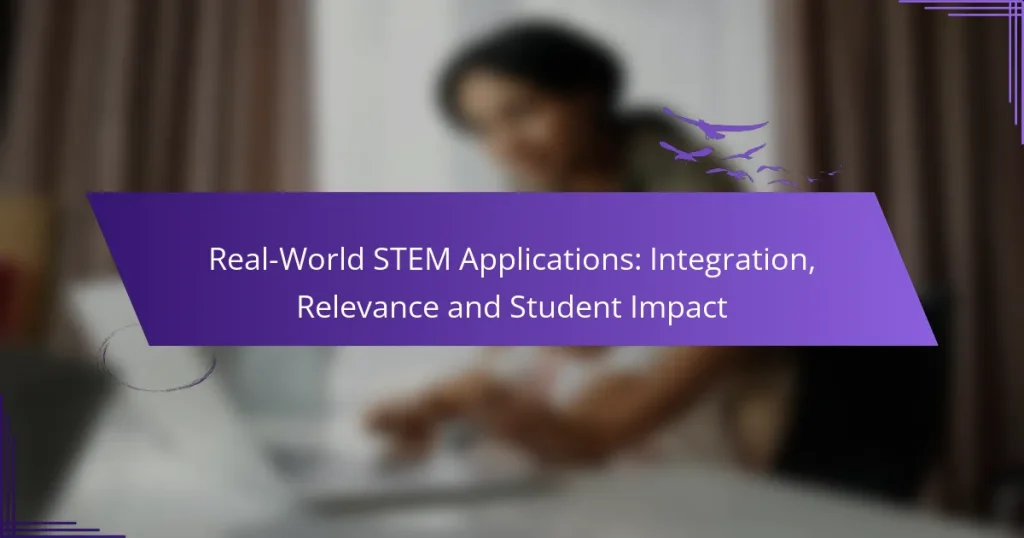Engaging STEM content is essential for effective online learning, as it combines interactive elements, real-world applications, and diverse media formats to enhance understanding. Platforms like Coursera, edX, and Udacity offer tailored courses that cater to various learning preferences and career aspirations. To ensure the content’s effectiveness, it’s important to assess learner performance and satisfaction through metrics such as surveys and engagement rates.
Gamification Techniques: Motivation, Learning Outcomes and Engagement
Engaging STEM Video Content: Development, Audience Appeal and Retention
Interactive STEM Learning Modules: Design, Engagement Techniques and Assessment
Audience Feedback Analysis: Improvement, Engagement Metrics and Resource Optimization
Culturally Relevant STEM Content: Inclusivity, Representation and Engagement
Real-World STEM Applications: Integration, Relevance and Student Impact
How to create engaging STEM content for online courses?
Creating engaging STEM content for online courses involves integrating interactive elements, real-world relevance, and diverse media formats. This approach captivates learners and enhances their understanding of complex concepts.
Utilize interactive simulations
Interactive simulations allow students to experiment with STEM concepts in a virtual environment, making learning more dynamic. For example, physics simulations can demonstrate forces and motion, enabling learners to visualize outcomes based on varying parameters.
When designing these simulations, ensure they are user-friendly and provide instant feedback. This immediate response helps learners understand the impact of their choices and fosters deeper engagement with the material.
Incorporate real-world applications
Linking STEM concepts to real-world applications makes the content more relatable and meaningful. For instance, discussing renewable energy technologies can illustrate principles of physics and environmental science while highlighting their importance in today’s society.
Consider using case studies or current events to show how STEM fields address global challenges. This contextualization can motivate students by demonstrating the relevance of their studies to everyday life and future careers.
Leverage multimedia resources
Incorporating multimedia resources such as videos, podcasts, and infographics can enhance understanding and retention of STEM content. Visual aids can simplify complex information, making it more accessible for learners with different learning styles.
For example, a short video explaining chemical reactions can complement written material, providing a multi-faceted approach to learning. Ensure that these resources are high-quality and directly related to the course objectives to maximize their effectiveness.
Foster collaborative projects
Collaborative projects encourage teamwork and communication among students, which are essential skills in STEM fields. Assign group tasks that require students to solve problems together, such as designing a prototype or conducting a research project.
Utilize online collaboration tools to facilitate communication and project management. This approach not only enhances learning outcomes but also prepares students for real-world scenarios where teamwork is crucial.
Implement gamification techniques
Gamification techniques can significantly increase student engagement by incorporating game-like elements into the learning experience. Features such as points, badges, and leaderboards can motivate students to participate actively and strive for mastery of STEM topics.
Consider designing challenges or quizzes that reward students for completing tasks or achieving milestones. This approach can create a fun and competitive atmosphere that encourages continuous learning and improvement.
What are the best platforms for STEM content delivery?
The best platforms for STEM content delivery include Coursera, edX, and Udacity, each offering unique features tailored to different learning needs. These platforms provide a range of courses from various institutions, allowing learners to choose based on their interests and career goals.
Coursera for diverse courses
Coursera offers a wide array of courses across multiple STEM disciplines, partnering with top universities and organizations. Users can find everything from introductory programming to advanced data science, making it suitable for learners at all levels.
One key feature is the flexibility of course formats, including self-paced and scheduled classes. This allows learners to balance their studies with other commitments, which is particularly beneficial for working professionals.
edX for university-level content
edX specializes in high-quality, university-level courses, often created by prestigious institutions like MIT and Harvard. This platform is ideal for those seeking in-depth knowledge and academic rigor in STEM subjects.
Courses often include verified certificates for a fee, which can enhance resumes and LinkedIn profiles. However, learners should be prepared for a more structured learning environment, which may include deadlines and assessments.
Udacity for tech-focused programs
Udacity focuses primarily on technology and programming, offering “Nanodegree” programs that are designed in collaboration with industry leaders. These programs are tailored to equip learners with practical skills that are directly applicable in the job market.
While Udacity courses can be more intensive and costly than others, they often include real-world projects and mentorship opportunities. This hands-on approach can significantly enhance learning outcomes and job readiness.
How to assess the effectiveness of STEM content?
To assess the effectiveness of STEM content, gather data on learner performance and satisfaction. This can involve various methods, including surveys, completion rates, and engagement metrics, which provide insights into how well the content meets educational goals.
Use learner feedback surveys
Feedback surveys are a direct way to gauge learner satisfaction and understanding of STEM content. Design surveys with clear, concise questions that focus on specific aspects of the content, such as clarity, relevance, and engagement. Aim for a response rate of at least 30% to ensure a representative sample.
Consider including both quantitative questions (e.g., rating scales) and qualitative questions (e.g., open-ended responses) to capture a range of insights. Regularly review and analyze this feedback to identify trends and areas for improvement.
Analyze completion rates
Completion rates indicate how many learners finish the STEM content as intended. High completion rates suggest that the material is engaging and accessible, while low rates may signal issues with content difficulty or relevance. Track these rates over time to assess changes in learner behavior.
For effective analysis, compare completion rates across different modules or topics. This can help pinpoint specific areas where learners struggle, allowing for targeted revisions to enhance content effectiveness.
Evaluate engagement metrics
Engagement metrics, such as time spent on content and interaction levels, provide insights into how learners interact with STEM materials. Tools like learning management systems (LMS) can track these metrics automatically. Aim to analyze both average engagement time and the frequency of interactions with key content elements.
Look for patterns in the data, such as which topics generate the most interest or where learners drop off. This information can guide content updates and help create more compelling learning experiences tailored to learner needs.
What are the key attributes of successful STEM content?
Successful STEM content is characterized by its relevance to current trends, clarity and accessibility, and the ability to engage users interactively. These attributes ensure that the content not only informs but also captivates and retains the audience’s attention.
Relevance to current trends
STEM content must align with the latest developments in science, technology, engineering, and mathematics to remain engaging. This includes incorporating recent discoveries, technological advancements, or educational methodologies that resonate with current societal needs.
For instance, discussing artificial intelligence applications in everyday life can attract interest, as this topic is highly relevant today. Regularly updating content to reflect these trends can enhance its impact and reach.
Clarity and accessibility
Clarity is essential in STEM content to ensure that complex concepts are easily understood. Using straightforward language, avoiding jargon, and breaking down information into digestible parts can significantly improve accessibility.
Visual aids, such as diagrams or infographics, can further enhance understanding. For example, a simple flowchart explaining the scientific method can help clarify the process for learners of all ages.
Interactivity and engagement
Interactive elements can greatly enhance user engagement with STEM content. Incorporating quizzes, simulations, or hands-on activities allows users to apply what they learn, making the experience more memorable.
For example, an online platform that offers coding challenges can motivate learners to practice their skills actively. Ensuring that these interactive features are user-friendly and accessible will maximize participation and enjoyment.
What are the prerequisites for developing STEM content?
Developing effective STEM content requires a solid understanding of educational standards, knowledge of the target audience, and familiarity with engaging teaching methodologies. These prerequisites ensure that the content is relevant, accessible, and aligned with learning objectives.
Understanding of educational standards
Familiarity with educational standards is crucial for creating STEM content that meets curriculum requirements. Standards such as the Next Generation Science Standards (NGSS) in the United States or the National Curriculum in the UK provide frameworks that guide content development.
When developing content, consider the grade level and specific learning goals outlined in these standards. For example, if targeting middle school students, ensure that the material aligns with the expectations for their grade, such as understanding basic physics concepts or mathematical reasoning.
Additionally, integrating assessments that reflect these standards can enhance the effectiveness of the content. Use formative assessments like quizzes or hands-on projects to gauge understanding and provide feedback, ensuring that learners are meeting the established benchmarks.

